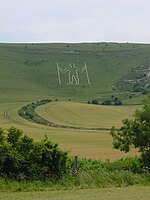Church of St Peter ad Vincula, Folkington
Church of England church buildings in East SussexFlint buildingsGrade I listed churches in East Sussex

The Church of St Peter ad Vincula, Folkington, East Sussex is a parish church dating from the 13th century. Built of flint and rubble, it is a Grade I listed building and an active parish church.
Excerpt from the Wikipedia article Church of St Peter ad Vincula, Folkington (License: CC BY-SA 3.0, Authors, Images).Church of St Peter ad Vincula, Folkington
Folkington Road, Wealden Long Man
Geographical coordinates (GPS) Address External links Nearby Places Show on map
Geographical coordinates (GPS)
| Latitude | Longitude |
|---|---|
| N 50.8128 ° | E 0.2121 ° |
Address
St Peter's Folkington
Folkington Road
BN26 5SA Wealden, Long Man
England, United Kingdom
Open on Google Maps








